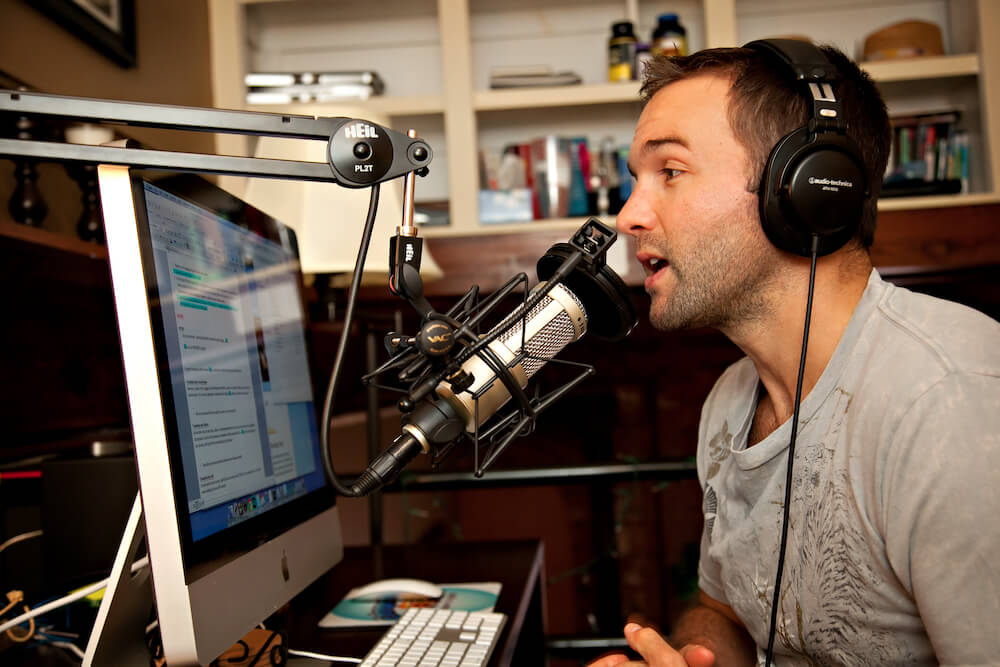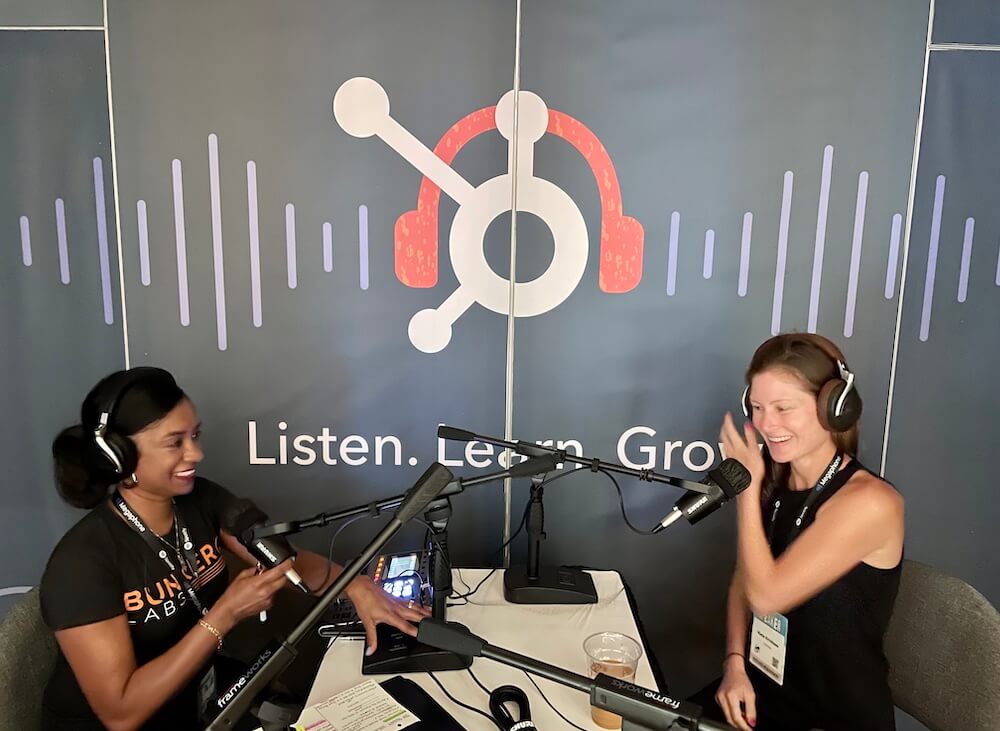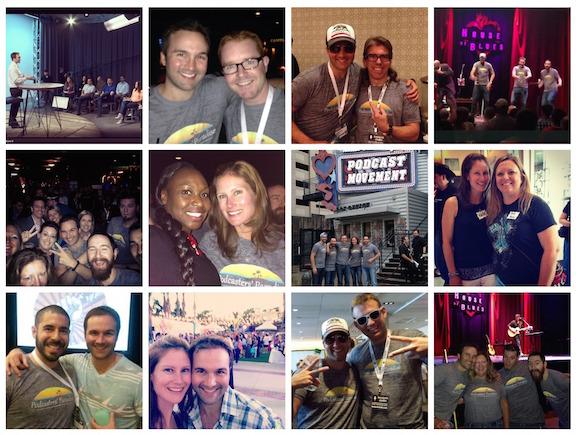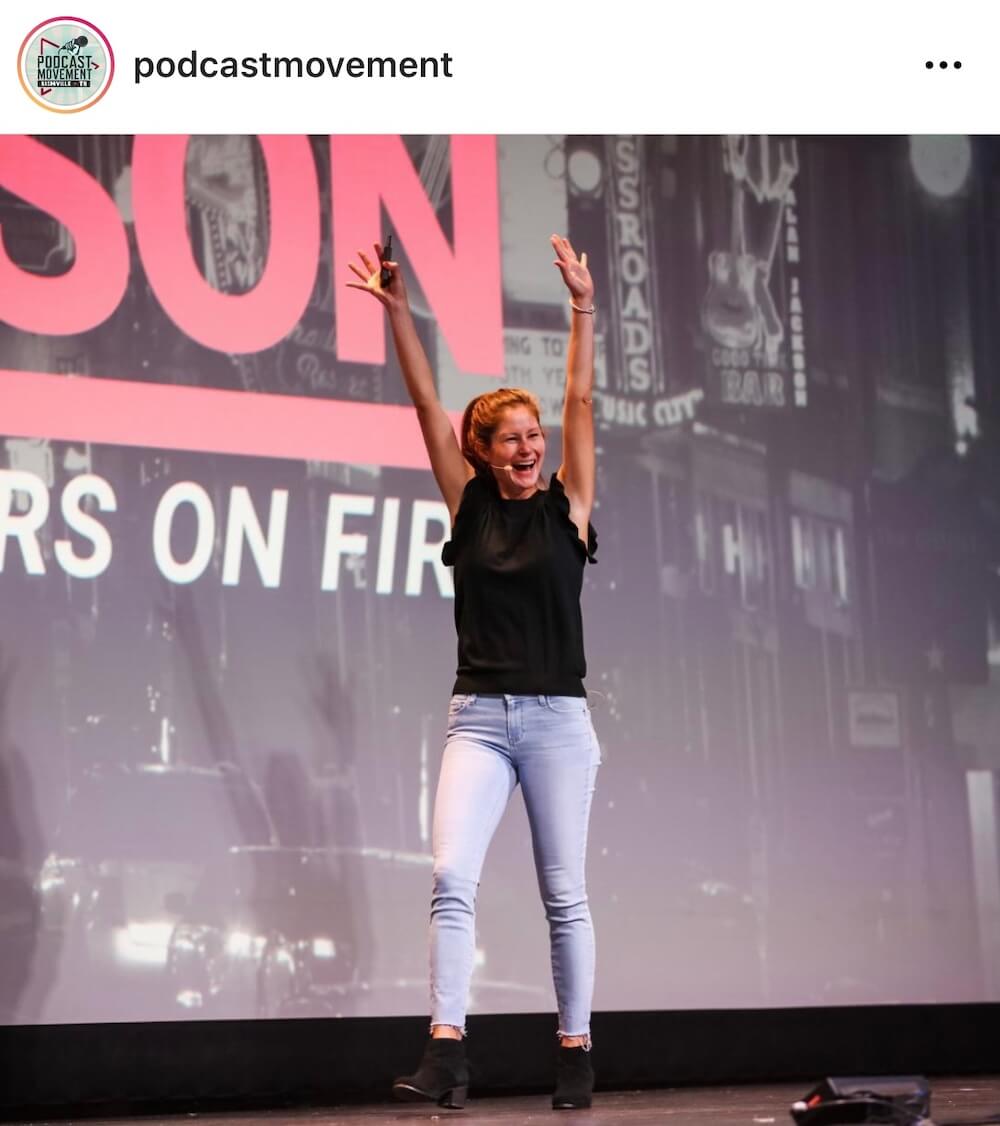You want to start a podcast, but you have a lot of questions about how much it costs to launch a podcast, what podcast equipment is best, how to record a podcast episode, and how you’re going to get people to tune in. There’s a lot that goes into it and this is your guide: podcasting for beginners!
Having launched over 20 podcasts ourselves, we know a thing or two about podcasting. And launching is just the beginning!
Once you’ve launched your podcast, there’s a whole new set of questions around how to grow your audience, and how to monetize your podcast.
That’s why we gathered together the most frequently asked questions from podcasters at every stage. So whether you’re a beginner, intermediate, or advanced podcaster, these FAQ’s will be incredibly helpful!
We’ve included several affiliate links below to share our favorite podcast products and services with you – ones we personally know and most of which we use ourselves.
So let’s kick things off with FAQ’s from podcasters who are just getting started.
Podcasting for beginners: FAQ’s
Is a podcast right for me?
Podcasting isn’t right for everyone and every business. But here are a few questions you can ask yourself to find out:
- Does my ideal avatar or customer consume audio content?
- Do I have a message and value to share with the world?
- Would I like to reach a world-wide audience with my content?
- Am I ready to create a deeper connection with my audience?
- Do I want to grow my audience?
- Can a podcast help my existing business as a new marketing channel?
If you answered yes to any of the questions above, then a podcast is definitely something you should consider. A few deeper-level questions you can ask yourself to confirm:
- Am I passionate about sharing my message via audio content?
- Do I see myself podcasting for at least a year, if not longer?
- Based on the projects and goals I currently have set for me and my business, does podcasting fit?
It’s important to be realistic when it comes to starting a podcast, because it is a lot of work and it’s going to take time to grow an audience and monetize, especially if you don’t already have an existing business.
That said, podcasting is one of the most powerful, fulfilling, and fun mediums we’ve ever dove into, and we wholeheartedly believe that it’s the best way to:
- Grow an audience
- Provide free, consistent value to an audience
- Gain more visibility for your business and brand
- Increase your authority and credibility as a leader
- Create a deeper connection with your audience than you ever thought possible
- Connect with some amazing individuals!
How do I come up with a podcast topic or idea?
Know you want to start a podcast, but not quite sure what you should podcast about?
Maybe you have several ideas for a podcast topic, but you’re not sure which one to choose.
Or you might be having trouble coming up with any ideas at all.
That’s exactly why we created the Zone of Fire exercise for you.
Zone of Fire Exercise
- Take out a sheet of paper and draw a line down the middle
- On the left hand side, write curiosity / passions; on the right hand side write skills / expertise
- Set a timer for 5 minutes, and fill in the left hand side with as many things as you can think of that you’re either curious about or passionate about
- Set a timer for 5 minutes, and fill in the right hand side with as many things as you can think of that are skills of yours or things you have expertise in doing
- If you’re having trouble coming up with at least 20 items in each column, reach out to family and friends and ask them “what types of traits, skills, or passions come to mind when you think about me?”
- Set a timer for 5 minutes and start making connections; where do your curiosities and passions meet your skills and expertise?
Here’s an example of what your paper might look like:
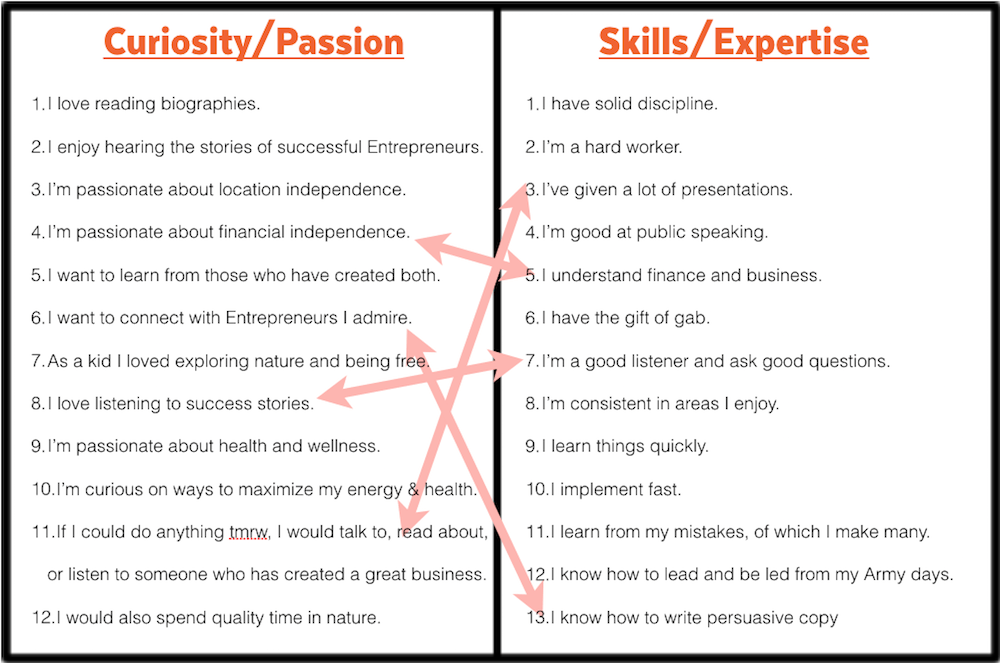
When you look at your connections, which elicit the most excitement in you – enough that you think you might just be able to start a podcast around that topic?
That is your Zone of Fire: where your passions and expertise merge.
How do I know whether people will listen?
It’s absolutely important to know there are people out there who will listen to your podcast, and you can do a lot of this initial “proof of concept” with a little bit of research.
- Google your podcast topic
- Search Apple Podcasts for your podcast topic
- Type into the Facebook search bar your podcast topic
- Look for videos on YouTube that talk about your podcast topic
Finding others who are already talking about what you want to podcast about – and who are successful in doing so – is proof of concept. It proves that there is a need and want that exists for this type of content, so congratulations!
What you have to ensure you do next – before you go any further with your podcast topic or idea – is come up with how you’re going to make your podcast unique.
How much does it cost to start a podcast?
Podcasting doesn’t have to cost a lot of money. In fact, if you were to put a dollar amount on my podcasting setup, here’s how it would breakdown:
- MacBook Pro (assuming you already have a computer: $0)
- ATR-2100 Microphone ($89 1-time investment)
- Apple Earbuds (assuming you already have a pair of earbuds: $0)
- Libsyn Podcast Hosting ($7 / mo)
- Adobe Audition Recording & Editing software ($20 / mo, but there are free options, too)
Total 1-time investment for me: $89
Total recurring monthly investment for me: $27 (If you use free recording and editing software, like Audacity or GarageBand, then it would only be $7)
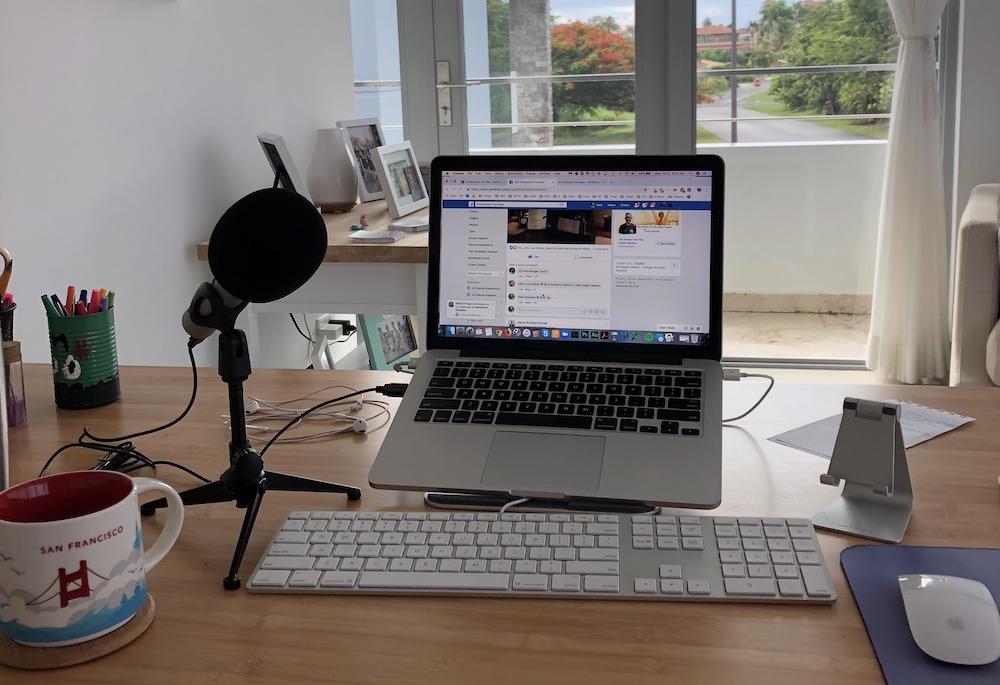
John’s podcasting setup is a lot more involved and his equipment is higher-level than mine. Again, you could spend a lot of money on equipment and recurring monthly expenses, but you don’t have to.
Now let’s look at some of the startup costs associated with creating and launching a podcast, and we’ll even throw in a couple of extra costs you might be looking at:
- Podcast Artwork (anywhere from $0 – $300+)
- Podcast Intro & Outro (anywhere from $0 – $600+)
- Website Hosting (starting at $4 / mo using our affiliate link for Bluehost)
- Social Media Scheduler MeetEdgar ($15 / mo)
- The Podcast Journal: Idea to Launch in 50 Days ($49 1-time)
When we say “starting at $0”, what we mean is you are very capable of doing this yourself. There are several DIY options that would cost you nothing, and going this route you could look to invest in an “upgrade” once you have more disposable income.
Looking at these startup costs – and even adding in some extra costs you don’t necessarily have to have…
Total 1-time investment: $89 for the ATR-2100 + $49 for The Podcast Journal = $138
Total recurring monthly investment: $7 for Libsyn (sign up with our affiliate link and get the rest of this month and next month free!) + $19 for website hosting and MeetEdgar = $26 / mo
Now do you see that podcasting doesn’t have to cost a ton of money?
What type of podcast equipment should I buy?
We are big believers in keeping your podcast setup super simple. The more fancy equipment you buy, the more difficult you make your setup, connections, and upkeep.
We’ve created an always-up-to-date list of all our top podcast equipment recommendations, but here’s the shortlist:
- Computer: MacBook Pro or Mac Desktop computer
- Microphone: ATR-2100
- Headphones: Apple Earbuds (or other earbuds)
- Pop filter for ATR-2100
- Boom arm (for a more permanent desk setup)
Here’s another option if you’re looking for a podcast equipment package with the ATR-2100 mic, pop filter, and boom arm.
How do I record my podcast?
Depending on the podcast format you’ve chosen, there are a couple of different ways to record your podcast.
If you’re doing topic-based solo episodes, then you can record directly into your recording and editing software, like Adobe Audition.
If you’re doing interview-based episodes, then you’ll need a way to connect with your guest and record the conversation. Some options include Squadcast, Zoom, or Zencastr.
If you’re doing Q&A episodes, then you’ll need a way for your audience to be able to call in their Q&A’s. SpeakPipe is a great tool for this.
If you’re doing in-person recordings then you’ll need a setup that’s easy to travel with. I travel with my ATR-2100 all the time, but depending on what type of in-person recordings you’ll be doing, you might need additional gear.
If you’re doing video interview episodes, then you’ll need a way to connect with your guest and record the conversation plus video. Most recording softwares offer this, including Squadcast, Zoom, or Zencastr.
What day of the week should I publish my podcast?
This depends on your podcast frequency, which we recommend be at least one time per week.
If you’re going to publish an episode one time per week, we recommend publishing your episodes on Monday morning.
Two times per week: Monday and Thursday mornings.
Three times per week: Monday, Wednesday, Friday mornings.
What about the exact time your episodes go live? We publish our episodes just after Midnight Eastern time. That means it’s available first thing in the morning where a majority of our listeners are (the US).
What’s the ideal length for a podcast episode?
The ideal length for a podcast episode is exactly how long it should be.
What we mean by this is: let your episode length be as short or as long as it takes you to provide real value to your audience.
If you just want to share a quick tip, then that might be 5 minutes. But if you’re interviewing someone on a bigger topic, then it might be 45 minutes or an hour.
Think of your avatar and what they would want. Maybe your avatar is a marathon runner, and therefore, they have a lot of time to listen to podcasts when they’re running. They might love a longer episode.
But what if your avatar is someone who commutes to an office and is in the car for about 25 minutes each way? They’d probably prefer a shorter episode they can finish during their drive.
What if I want to do a video podcast?
Video podcasts are great, and platforms like YouTube can definitely offer you additional exposure.
But don’t create a video podcast just to create a video podcast.
There are certain topics and content that lend to video. If you’re demonstrating something, then a video will probably be really helpful. But if you’re simply having a conversation, video might not be necessary (as it does add to your to-do’s).
Consider whether your avatar would actually tune in to a video.
Consider the amount of time you have to dedicate to your podcast production.
Then go from there!
Where do I host my podcast?
Our top choice is Libsyn, and if you use our link you’ll get the rest of this month and next month free!
We’ve also put together a post to compare a few of the top podcast hosting platforms.
What are top tips for launching a podcast the right way?
Launching a podcast is a big deal! You’ve worked so hard to get to this point, and you want to make sure you’re doing it the right way. Kudos!
Our top 3 tips for launching a podcast the right way are:
- Launch with 3 episodes (including you “trailer”, or About Me episode), and a month’s worth of content in the bank
- Have a content schedule in place so you don’t fall behind your publishing schedule
- Create a marketing plan so that you’re consistently sharing your podcast!
To help you make sure you’re fully prepared for launch, we put together an epic guide on How to Start a Podcast: From Idea to Launch and Beyond. Check it out for more in-depth tips for preparing for your launch!
What directories should I submit my podcast to?
At the end of the day, the more places you can be found, the better. But there are some major players in the space where you’ll definitely want to submit your podcast.
Because each directory has a different set of requirements and boxes you need to check in order to submit your podcast, we put together this post on where to add your podcast so you have everything in one place.
Podcasting for intermediate podcasters: FAQ’s
What’s a good number of downloads per episode?
The average number of downloads per episode is roughly 130. That’s after it has been live for 30 days.
So a good number of downloads per episode is anything higher than that.
To take it a step further, I’d say a good number of downloads per episode is a number that’s higher than what you were seeing the previous month. Month over month growth is important, and I believe it a good indicator that you have new listeners – and recurring ones – tuning in.
How do I know if my podcast is doing well or not?
This depends on what goals you have set for your podcast – an important step in the process.
If you have a specific goal set for your podcast, then you’ll know whether your podcast is doing well based on whether you’re accomplishing your goal.
For one podcaster, that might be to have awesome conversations with leaders in their industry, and so getting a “yes” from a potential guest could mean their podcast is doing well – since that was their goal.
For another podcaster, it might be to increase their business revenue by 10% (they’re using the podcast as a marketing arm to promote existing products or services). This one might take a bit longer to gauge, so realize that you might have to track metrics over several weeks – or even months – before you’ll know whether it’s working.
Growing an audience doesn’t happen overnight.
Set a goal for your podcast, and make sure it’s measurable in some way so you can track it. Then you’ll know whether your podcast is doing well. And remember that everyone’s podcast is different. Don’t compare yourself to anyone else but YOU yesterday.
How do I grow my podcast audience?
There are multiple ways to grow your podcast audience, and we created a post on the 7 Growth Hacks for Your Podcast.
Again, growing an audience doesn’t happen overnight. There really are no “shortcuts”.
Create valuable and free content you know your audience wants and needs, and do it consistently over time. That’s the formula!
And one of the best ways we know to grow a podcast is to be a guest on other podcasts. Here’s a post that breaks down How to Guest Podcast.
How do I know if anyone is listening?
Ask! Engaging with your listeners is a key step towards building an audience and creating that know/like/trust factor.
How do I engage with my listeners?
We’re glad you asked! Engagement comes in all different shapes and sizes, so don’t assume it has to be a one-on-one convo that you’re preplanned or anything.
Engagement is happening all the time – you just have to be ready to receive it, and talk back.
Here are a few examples of potential “engagements” with your listeners:
- A listener reaches out to you via email and tells you they enjoyed the most recent episode
- A listener comments on one of your social media posts and shares how they found out about your podcast
- You’re in a Facebook group and someone asks a question related to your area of expertise
All of the examples above are opportunities for you to engage with your listeners. If you find yourself in any of these scenarios, respond back with a question – ask if there’s a topic they’d like to hear on an upcoming episode. Ask how they found out about your podcast. Ask them what their biggest struggle is right now.
Start a conversation.
How do I get listeners to subscribe to my podcast?
Ask! When one of your listeners reaches out – via email, social media, or on your website – you can ask them to subscribe to your podcast.
To make it super easy, it’s great to have a page to send them to that has all of your links in one place, so that no matter where they listen to podcasts there’s a quick way for them to get to yours.
Here’s an example: EOFire.com/subscribe
How do I get listeners to leave a rating & review for my podcast?
Ask :) Again, any time one of your listeners reaches out to you – no matter what medium they’re using – at the end of your reply let them know how much it would mean to you if they leave a rating and review.
Cool services like Rate This Podcast make it super easy for you to provide a link for people to go straight to reviewing your podcast on certain platforms, so definitely check that out to make it super easy for people.
What’s the best way to grow my podcast?
There are several ways you can grow your podcast. Spoiler alert: they all take time, energy, and effort.
Here’s our Ultimate Guide on How to Podcast, which includes many proven ways you can grow your podcast.
Should I join a podcast network?
Joining a podcast network is a big decision, and it should be one that you talk to several people about (especially if you share your podcast with a co-host or other partners).
Podcast Networks can offer a lot for a podcast. Some also take a lot. So it’s best to do your due diligence and really think about whether it’s the best move for YOU given your podcasting goals.
We wrote a podcast on whether you should join a podcast network so you can sort through all the considerations and make the best decision for you.
Is using Patreon a good idea for my podcast?
It’s definitely worth a try!
Some people do really great with Patreon, and it’s a proven platform to help generate revenue for your podcast.
As with most things having to do with your podcast, whether you should is going to depend.
We provide some questions to ask yourself and things to consider in our post on How to Use Patreon as a Podcaster.
Podcasting for advanced podcasters: FAQ’s
How do I take my podcast to the next level?
When you’ve hit a stride with your growth and have seen a consistent increase month over month for at least six months, then it’s time to kick it up a notch!
What will help you take your podcast to the next level is building a Super Funnel.
A Super Funnel is what will lead your ideal listener on a journey, starting with your podcast, and leading them all the way to your paid product or service.
There are essentially six steps:
Step 1: Ask your audience what their biggest struggle is
Step 2: Brainstorm a solution in the form of a product, service, or community – get proof of concept by offering the idea to your audience, and ask them if they’d be willing to pay money for it (you could even pre-sell it)
Step 3: Create an opt in that gives away something for free – a “first step” towards the solution you’re going to create
Step 4: Market the opt in you created on your podcast with a call to action in every episode
Step 5: Build out an email campaign that guides your listener to the next step
Step 6: Offer them the solution (product, service, community)
Here’s one of our Super Funnels in action:
Step 1: Ask your audience what their biggest struggle is: Our audience told us they wanted to start a podcast, but they didn’t know how
Step 2: Brainstorm a solution in the form of a product, service, or community: We imagined a community and membership that taught people how to create, grow, and monetize their podcast; we offered it to our audience, and 50 people pre-paid for it!
Step 3: Create an opt in that gives away something for free – a “first step” towards the solution you’re going to create: We created Free Podcast Course, where you’ll learn how to create and launch your podcast – free! FreePodcastCourse.com
Step 4: Market the opt in you created on your podcast with a call to action in every episode: We promote Free Podcast Course in every podcast episode
Step 5: Build out an email campaign that guides your listener to the next step: After you opt in for Free Podcast Course, we also offer our Podcast Masterclass as the “next step”: ThePodcastMasterclass.com
Step 6: Offer them the solution (product, service, community): On The Podcast Masterclass, we offer Podcasters’ Paradise, our paid community and membership where you’ll learn everything you need to know to create, grow, and monetize your podcast!
How do I monetize my podcast without bringing on sponsors?
There are several ways to monetize a podcast without bringing on sponsors. Here are just a few:
- Affiliate partnerships
- Creating a digital product for your audience
- Creating a service for your audience
- Hosting in-person or virtual events
- Patreon or other donation channel
- Launching physical products
- Subscription model (pay for bonus content)
How do I lock in my first sponsor?
We created the Ultimate Guide to Podcast Sponsorships, which breaks down every step of bringing on your first sponsor! We go into great detail about the various options you have for bringing on sponsors, and examples of email templates and more so you can reach out to your first sponsor!
What’s the best way to come up with an offer for my audience?
To ask them one question: What’s your biggest struggle right now?
You can ask your audience this question on your podcast, in email communications, via social media, at in-person events or at a conference, in a virtual event setting, and more.
Every engagement with one of your listeners is an opportunity to learn what they’re struggling with right now.
The recurring answer that keeps coming up again and again is what you should create the solution for – and that solution is your offer.
How do I get speaking engagements?
If you’re interested in speaking on stage we have a post all about How to Land and Leverage Speaking Engagements.
It starts with having a go-to topic or niche that you’re an expert at, and leading with that.
What’s one thing you know now that you wish you would have known when you first started?
That getting started – and continuing to take action every single day – is the best action you can take.
It’s not about getting to the finish line. And I’ll tell you right now: there are no shortcuts.
Sit down, write out a plan, and follow that plan. If you need a plan, we have one for you: The Podcast Journal – Idea to Launch in 50 Days. This is your step-by-step guide to launching your podcast in 50 days or less.
Each day The Podcast Journal will guide you in taking one step closer to your podcast launch.
Don’t want a journal? Here’s our Complete Guide to Starting a Podcast.
You’ve got this!
